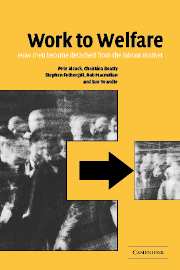Book contents
- Frontmatter
- Contents
- List of figures
- List of tables
- Notes on the authors
- Preface
- List of abbreviations
- Part I The context for labour market detachment
- Part II New evidence from the UK
- 4 The detached male workforce
- 5 Incapacity Benefit and unemployment
- 6 The over 50s
- 7 Family, life course and labour market detachment
- 8 The role of health in labour market detachment
- 9 Getting by
- 10 Back to work?
- Part III The policy implications
- Appendix: Research methodology
- References
- Index
5 - Incapacity Benefit and unemployment
Published online by Cambridge University Press: 22 September 2009
- Frontmatter
- Contents
- List of figures
- List of tables
- Notes on the authors
- Preface
- List of abbreviations
- Part I The context for labour market detachment
- Part II New evidence from the UK
- 4 The detached male workforce
- 5 Incapacity Benefit and unemployment
- 6 The over 50s
- 7 Family, life course and labour market detachment
- 8 The role of health in labour market detachment
- 9 Getting by
- 10 Back to work?
- Part III The policy implications
- Appendix: Research methodology
- References
- Index
Summary
‘Sickness’ and ‘unemployment’ have usually been regarded as two separate, unconnected reasons why men do not work. Some men are too ill to work; others simply cannot find work. Of course, for many men without jobs this clear-cut distinction between sickness and unemployment remains entirely valid.
In reality, however, the world is more complex. It has long been recognised, for example, that there is a feedback from unemployment to ill-health – that the stress and loss of earnings associated with unemployment sometimes leads to deteriorating health (see, for example, Bellaby and Bellaby 1999). It is also true that there are many degrees of sickness, from an inability to do any work in any circumstances through to much milder limitations which restrict only the type or quantity of work a person can undertake. Added to this is the impact of benefit rules that define exactly who is eligible to be counted as sick and who as unemployed and which shift through time and vary from country to country, as ch. 2 emphasised. Where then does ‘unemployment’ stop and ‘sickness’ start? Is it really so easy to draw a line between the two?
In this chapter we explore the relationship between recorded sickness and recorded unemployment among men of working age. Once again the evidence is drawn from aggregate figures for the UK and from the survey of non-employed men first deployed in ch. 4 and described in full in the appendix.
- Type
- Chapter
- Information
- Work to WelfareHow Men Become Detached from the Labour Market, pp. 111 - 139Publisher: Cambridge University PressPrint publication year: 2003
- 3
- Cited by

